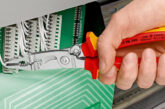
Frank Bertie, Chief Technical Officer at NAPIT, explains new inspection and testing requirements under Amendment 2.
As part of any electrical installation, there is a requirement to undertake inspection and testing of the work prior, during and on completion. In light of the introduction of BS 7671:2018+A2:2022 Amendment 2, we need to review the changes and incorporate them into our inspection and testing procedures.
Within the regulations, this varies between revision of existing, brand new and the deletion of some of the old favourites. The model forms listed in Appendix 6 have also been revised, which will result in changes in the current versions of certificates and reports.
This article provides a brief overview of the new amendment and how it will impact those carrying out the inspection and testing of electrical installations.
Requirements
In looking at requirements for inspection and testing, the first step is to open Part 6 and read Chapters 64 & 65, which cover initial verification and periodic inspection and testing.
To begin, let us take a look at the introduction of the amendment, which includes a summary of the changes, a foreword by the Health and Safety Executive, and the Notes on the plan of the 18th.
Introduction to BS 7671:2018+A2:2022
The following summary highlights the main revisions from the existing BS 7671:2018+A1:2020 version in brief. One of the first points is the explanation of when Amendment 2 became effective – 28th March 2022 (it can be used immediately after this date), and when the previous edition will be withdrawn – 27th September 2022.
Additionally, there is clear information regarding the fact existing installations carried out to an earlier edition may not comply with the current version, but this does not mean that the installations are unsafe or require upgrading.
In addition, there is a provision of contractual duties and the Note 1, which states parties subject to a contract may install to a withdrawn standard. This includes the type of work that involves a long-term project, which can start prior to the introduction of the new version and extend after the standard has been withdrawn.
Initial Verification
The Standard applies to all new electrical installations and each part of BS 7671 that is relevant to a particular installation must meet the requirements of the Wiring Regulations. Although Part 6 covers inspection and testing, it includes an inspection to ensure the installation meets the Wiring Regulations.
One of the main changes in the testing regulations, 643.3, refers to insulation resistance, where the 500 V IR test will be carried out prior to the connection of any equipment that is likely to be influenced or damaged by the IR test. There would then be an additional test at 250 V following the connection of the equipment. This change is made to ensure that the cables are fully tested after erection to ensure that they have not been damaged.
RCD testing has been revised to include a test of only IΔn which is the rated residual operating current of the RCD.
Appendix 6 Model Forms
The forms have undergone many revisions and there are some welcome changes in the extensive schedule of inspections for the Electrical Installation Certificate (EIC), a cumbersome list of inspections. As a result, there will be a reduction in the number of pages for the EIC, where the new schedule of inspections now consists of 14 items, as shown in Fig 1.
Though the previous schedule of inspections is no longer to be attached to the EIC, it still includes an example checklist of the items that must be inspected during the initial verification. This example has been included as an aid memoir to assist in the completion of the 14 new items on the schedule of inspections.
There are some minor changes to the Minor Electrical Installation Works Certificate (MEIWC) and the Electrical Installation Condition Report (EICR) with the inclusion of Arc Fault Detection Devices and Surge Protective Devices.
There is a major change to the schedule of test results, which has now been replaced by a schedule of circuit details and a schedule of test results due to the increased number of columns, as shown in Fig 2 & Fig 3.
Conclusion
A significant amount of attention will need to be given to the changes introduced within the inspection and testing parts, chapters and appendices, in order to ensure the correct initial verification and periodic inspection and testing of electrical installations.
You can maintain your Continuing Professional Development (CPD) through several options, including NAPIT EXPO events, three different NAPIT training options, NAPIT webinars, and The Competent Person magazine.
You can find information about inspection and testing procedures in NAPIT’s publications that have been updated to Amendment 2 on the NAPIT Direct website. Additionally, you can access CPD opportunities through NAPIT Training and NAPIT events.
To view NAPIT’s updated Amendment 2 publications, click here
To get more details on NAPIT training and events, click here










